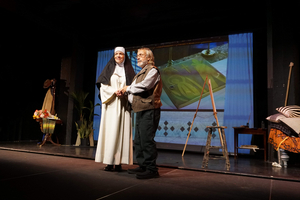Review: 'A MODEL FOR MATISSE' at Midnight Company

Joe Hanrahan and his Midnight Company are presenting A Model for Matisse. It's the premiere of a new work about the great artist and the unusual relationship that led to his masterpiece in the last years of his life--the wonderful Chapel of the Rosary in the small town of Vence on the French Riviera.
Henri Matisse had lived near Nice for decades. In 1941, when he was 72, a cancer operation left him bedridden. He advertised for "a young and pretty night nurse" to tend to him-and Monique Bourgeois came into his life. Matisse asked her opinion of one of his paintings. She replied, "I like the colors a lot, but the lines . . . not so much." Her honesty delighted him. Over the next several years Monique became his companion, friend, model, and indeed student, for she had artistic talent and aspiration of her own.
Joe Hanrahan portrays Matisse. It's the oldest role I've seen him do, and he's padded up to the elderly Matisse's portly dimensions, but there's still the twinkle and charm that characterize this actor. And Rachel Hanks, a familiar presence on St. Louis stages, gives I think the best performance I've seen from her. This is perhaps odd, because Monique is not a dramatic or theatrical type at all; she's an innocent, cheerful young woman. But Miss Hanks simply glows with youth and honesty; her laugh is so easy and natural.
The two bond deeply despite the fact that Matisse is an atheist and Monique a devout Catholic. Their gentle flirtation is that of a grandfather and granddaughter.
The friends part when Matisse's regular nurse returns, but fate brings them together again a few years later. He moves to the small village of Vence to avoid the risk of coastal bombing--and finds that Monique is recovering from tuberculosis in a Dominican convent just across the street. The friendship is rekindled. She does a bit more modelling. But then Monique finds herself called to become a nun and (over Matisse's strong objection) she joins the convent, thus ending her daily contact with her good friend. She is now Sr. Jacques Marie.
Later as plans for a chapel are begun Sr. Jacques' friendship with the great artist draws him enthusiastically into the project. The Mother Superior is vehemently opposed to the idea: "A chapel designed by an atheist who paints nudes?!! Never!" It's a long and difficult political struggle, but in the end art and love win out.
Director Ellie Schwetye has put together many beauties in this production. She herself designed the lovely sound plot--a little Satie, some Fauré , a touch of Ravel, playing unobtrusively under the dialogue like a movie score. The quite gorgeous video design is by Michael B. Perkins: a Riviera view from Matisse's studio, a profusion of flowers, and of course much of the art he creates for the chapel. The excellent costumes are by Liz Henning. (Her angel-white habit makes Sr. Jacques a very icon--and it becomes a canvas to receive the colored light from the chapel's windows.)
The script is based on a 2003 documentary film by Barbara F. Freed, who co-authored this adaptation with Hanranan. It's charming, but it really never quite makes the step from documentary to drama. Monique is both character and narrator, and some of her early speeches are pretty bald exposition--like a documentary voice-over. A time or two, as when Church officials are introduced with photos, the tone almost becomes that of a slide-show.
We meet these two singular people, we learn some of Matisse's artistic philosophy and of his long friendship with Picasso, whom he met at Gertrude Stein's famous salons. We are told of the fierce conflict with the Mother Superior--but this conflict is not seen, it is merely described (as in Greek drama, where all the slaughter happens off-stage and is recounted by a Messenger).
There are missing persons whose live presence would help attain a sense of drama. I know there are quite practical reasons for keeping a cast small, but the Mother Superior deserves a live scene. And poor Lydia Delectorskaya, Matisse's long-time secretary and household manager. An impoverished, orphaned Russian emigrée, she had, in her youth, modeled for Matisse ("The Pink Nude" and others). Matisse's wife suspected an affair; this led to a separation and to Lydia's attempted suicide; but Lydia remained in his employ to the end. The stuff of drama, no? And yet she is denied the stage. What did she think of Monique?
"A Model for Matisse", now playing at the .ZACK, is a lovely story of a gentle relationship and of the genesis of an artistic masterpiece. It plays through September 21.
Videos
